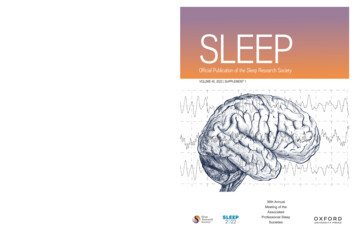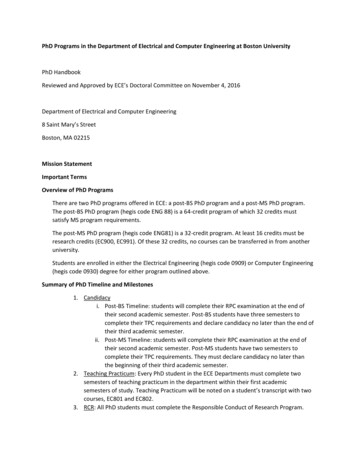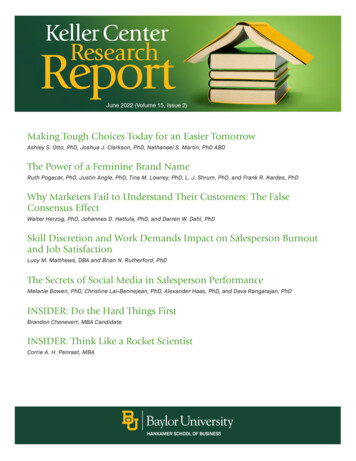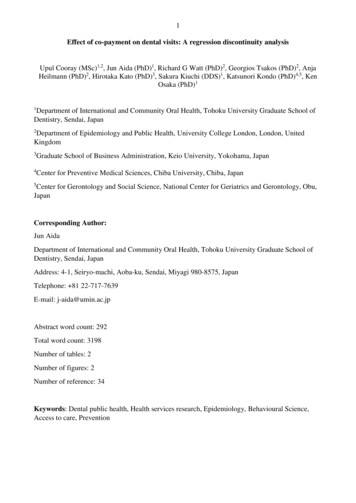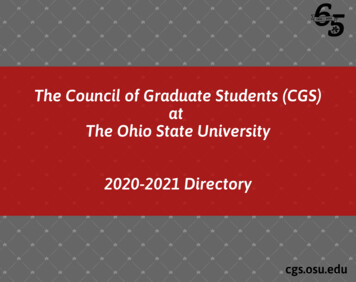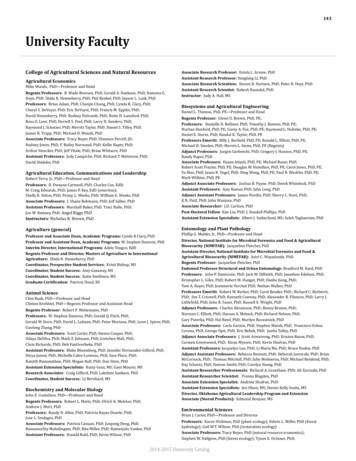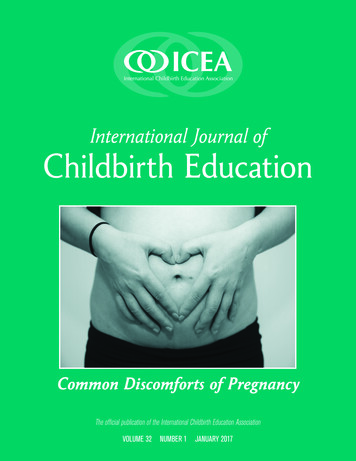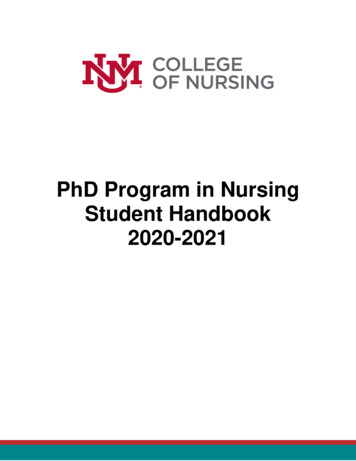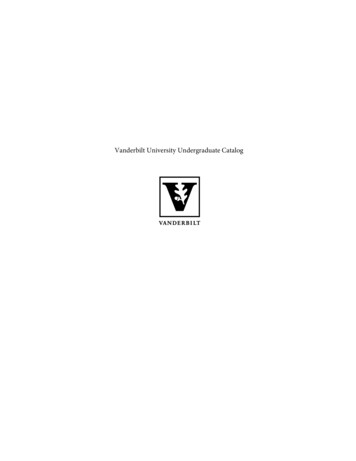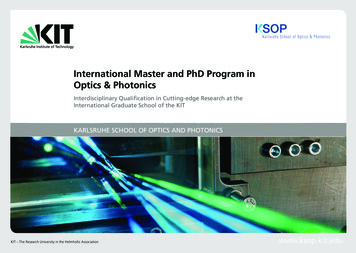
Transcription
International Master and PhD Program inOptics & PhotonicsInterdisciplinary Qualification in Cutting-edge Research at theInternational Graduate School of the KITKARLSRUHE SCHOOL OF OPTICS AND PHOTONICSKIT – The Research University in the Helmholtz Associationwww.ksop.kit.edu
RELEVANCE OF OPTICS & PHOTONICS FOR THE FUTUREDirectory Board MessageSince the year 2000, more than 10 Nobel Prizesdirectly linked to Optics & Photonics have beenawarded. This includes not only basic researchbut also application oriented breakthroughsthat facilitated the transformation of oursociety. Energy-efficient light sources, opticalcommunication and digital camera systemsare impressive examples. At the same time,the discipline is mobilizing innovation-drivenbranches of our economy, such as industrialautomation and production, digitalization of thesociety, autonomous mobility as well as medicaltechnologies and personal health monitoring.The future progress and growth in this field relyon dedicated researchers and graduates trainedin an interdisciplinary environment. In 2006 theKarlsruhe School of Optics & Photonics (KSOP)was founded as one of the first graduateschools within the scope of the German„Excellence Initiative“ at the Karlsruhe Instituteof Technology (KIT). KSOP brings together thebest talents in engineering and natural sciences.Comprising a Master‘s and a Ph.D. Program inOptics & Photonics, the educational concept isdesigned to qualify its graduates for acceleratedcareers at world leading academic institutionsand in high-technology industries.KSOP as a premium research and education hub.Join us as a student, a doctoral researcher or asan academic or industrial partner.We are looking forward to a rewardingcollaboration.KSOP actively promotes the thesis work of itsdoctoral researchers by dedicated supervision,mentoring, networking as well as scientificand technical training. Concomitantly, KSOPaugments the professional skills of its graduatesby tailored personal and management training.Currently, KSOP encompasses professors from16 institutes and four different faculties, i.e.Physics, Electrical Engineering and InformationTechnology, Chemistry, and Biosciences, as wellas Mechanical Engineering. Over 700 students,Ph.D. candidates and alumni have positionedProf. Dr. Ulrich LemmerCoordinatorKarlsruhe School of Optics & Photonics3
4
STRONG PARTNER FOR INDUSTRYQualification for InnovationThe KSOP prepares students and doctoralresearchers for the labor market of theGerman and worldwide Optics & Photonicsindustry. The close cooperation to industrypartners is of high value for industry on theone hand and KSOP students and doctoralresearchers on the other hand.Advantages for Industryplatinum cooperation partnership with KSOPand profit from its network, e.g. recruit youngprofessionals for practical training, a master’sthesis or jobs.contact with potential future employers andprepare for their professional careers.Advantages for Students and DoctoralResearchers Internships & master’s thesis projects Recruiting events, i.e. the KSOP CareerFair or company excursions Networking events between science &industry, i.e. the symposium KarlsruheDays of Optics & Photonics (KDOP)By gaining experiences in well-knowninternational companies via internships ormaster’s thesis projects, students get inKSOP Fosters the Interface Between Industryand Its Members Via:KSOP industry partners have an exclusive accessto high potential and international juniorstaff. The research and teaching environmentfosters innovations and empowers theindustry partners to ensure their technologicalcompetitiveness.On top of this, the challenge to solve socialand technological problems can only bemanaged by cooperations between research,industry, and politics. Therefore, the initiativePromotion of Junior Researchers in Optics &Photonics was founded by KSOP. Industrypartners can choose from a gold, silver &The KSOP Career Events: A Meeting Point Both for Industry & Future Employees5
6
KSOP QUALIFICATION PROGRAMSMaster‘s & Ph.D. ProgramsThe KSOP educational concept is designed toqualify its graduates for accelerated careers atthe world’s best academic institutions and inoptic & photonic high-technology industries.The 2-year Master’s Program spans thebridge between undergraduate classes innatural and engineering sciences and therequired in-depth knowledge that is essentialfor cutting-edge research. It qualifies for afurther career in the industry as well as inresearch. For those who would like to continuetheir careers in research, KSOP establishedan exclusive Ph.D. Program. KSOP also is amember of the European Erasmus MundusMaster’s Program EUROPHOTONICS.Advantages for Students,Researchers & Industrye.g., within the M.Sc. program includinglaboratory courses, research projects, industryinternships, and German courses tailored tothe qualification of international students.Concomitantly, the professional skills of thegraduates are enhanced by tailored personaland management training, e.g., in the MBAFundamentals Program.A strong pillar of the Ph.D. qualificationconcept is the individual coaching andsupervision of its doctoral researchers by theresearch area mentors. On top of this, KSOPactively promotes the thesis work of its doctoralresearchers by scientific and technical training.DoctoralBy fostering a strong industry partnerprogram, KSOP identified the requirementsof O&P companies on its graduates. Thosedemands and specifications were integrated,The KSOP Success Story: Over 700 Master, Ph.D. Students & Alumni From 40 Different Countries7
KSOP QUALIFICATION PROGRAMS*An eight-week internship will take place eitherbetween the 2nd & 3rd semester or between the3rd & 4th semester. This internship is creditedwith 12 ECTS.*¹ Suitable B.Sc.: Physics, Chemistry, ElectricalEngineering, Mechanical Engineering, Mathematics, Optics & Photonics, Computer Science,Biology, Biotechnology, Biomedical Engineering8
MASTER‘S PROGRAMInterdisciplinary ApproachThe KSOP M.Sc. Program aims at educatingexcellent students in Optics & Photonicsworldwide. The interdisciplinary researchstructure of the international graduate schoolforms the basis for this outstanding Master’sprograminternational studying atmosphere to theMaster’s program. KSOP students also havethe opportunity to join the worldwide OSAand SPIE network through the OSKar studentchapterat KIT.Prerequisites: B.Sc. Degree in natural orengineering sciencesIndustry internship program & networkingIntensive lab training, language courses,business etiquette trainingWhat‘s Unique About the Program? Industry Network: The studies include anelaborated industry internship program withpartners from the Optics & Photonics industry.Furthermore, company visits and career eventsare offered regularly to all students. International Student Community:Students from all over the world convey an2-year Master‘s Program in Optics & PhotonicsSpecializations: Photonic Materials &Devices, Advanced Spectroscopy, BiomedicalPhotonics, Optical Systems, Solar EnergyCompletely taught in English, the programis developed for 40 students each year whoapply with a completed Bachelor’s degree innatural or engineering sciences. Scholarships: For outstanding studentswho are among the best 10% students oftheir class, scholarships are offered.Keyfacts:Fatemeh HosseiniOptical Engineer, Robert Bosch GmbHKSOP Alumna“For a person like me who is fascinated by every aspect of Optics andPhysics, the broad study plan of KSOP was definitely an eye-catchingparameter. In addition, the cooperation of KSOP with the industryand its emphasis in acquiring additional soft skills were what motivated me to apply for this program. Although I am working as anOptical Engineer, I can use my experience and knowledge from otherdivisions proposed by KSOP and be more innovative. I guess mostof KSOP students agree on the fact that studying at KSOP is not justabout having great courses with sophisticated professors and beingexposed to leading industries. It was also about people who werealways there to support you. The different backgrounds of my classmates gave me a great opportunity to get to know other culturesand broaden my view towards the world and life. Overall, KSOP hadeverything that I could ask from a Master’s program and then some.”9
KSOP QUALIFICATION PROGRAMS*Suitable M.Sc.: Physics, Chemistry, Electrical Engineering,Mechanical Engineering, Mathematics, Optics & Photonics,Computer Science, Biology, Biotechnology, Biomedical Engineering10
PH.D. PROGRAMResearch Concept for SuccessThe Ph.D. candidates are embedded inthe excellent research environment of KIT.Integrated into the international graduateschool, the doctoral researchers pursue theirprojects autonomously within one of theKSOP research areas.One of the core elements of the KSOP Ph.D.program forms the specific modular training,which includes units from a catalog oftechnical, scientific as well as managementand personal key competence modules. Sincesuccessful careers in the industry or academiaoften require leadership and interdisciplinaryknowledge, emphasis is laid on managementskills, which are taught as mandatorymanagement modules at the HECTORSchool of Engineering & Management, theTechnology Business School of KIT.Supervision & MentoringA Ph.D. advisor, a co-advisor, and a mentoraccompany the research work of each doctoralresearcher by meetings on a regular basis. Thissupervision concept ensures both rapid progressand the successful completion of a thesis.credit points gained in the program arerecognized in any international MBA program.KeyfactsManagement Plus3-year Ph.D. ProgramThe optional MBA Fundamentals Programoffers the opportunity to deepen the keenlydemanded knowledge within six units of fivedays. The certificate and the correspondingPD Dr.-Ing. Timo MappesSenior Vice President InnovationCarl Zeiss Vision Care InternationalScholarship ProgramSupervision & MentoringAdditional Management Skills, Technical,Scientific & Key Competence Modules,Networking“I was heading an independent (junior) research groupbetween 2007 and 2012 on integrated optofluidic systemsfor biophotonic applications. All of the Ph.D. studentswithin my group joined KSOP, especially appreciating thescientific networking within KSOP. It is essential for yourfuture career to address challenging scientific questionsin cross-disciplinary teams, no matter if you stay inacademia or if you join the industry - this is exactly whatI am experiencing in my daily business. Today, I am thehead of global R&D and IT for ZEISS Vision Care. There areabout 170 employees on four different continents workingjointly on new and novel solutions for spectacle lenses pushing technology beyond limits by combining internalexpertise with external knowledge.”11
KSOP QUALIFICATION PROGRAMSwww.ksop.kit.edu/erasmus.php12
EUROPHOTONICS MASTER‘S PROGRAMPhotonics in EuropeProgram & Mobility StructureNext to its own Master’s program, KSOP is alsoa member of the European Erasmus MundusMaster’s Program EUROPHOTONICS.Semester 1: Fundamentals (AMU)Semester 2: Core Subjects & Industry Internship (KIT or AMU)Semester 3: Specialization (KIT, AMU or Barcelona)Semester 4: M.Sc. thesis (KIT, AMU or Barcelona)The EUROPHOTONICS Master’s offersexcellent teaching at top-level universitiesand individual study mobility throughoutEurope. An extensive two-year master-levelteaching program focused on advanced andapplied research topics that will constitutethe near and extended future scientificgoals in the field of Photonics Engineering,Nanophotonics, Biophotonics, and theirinterdisciplinary applications.Depending on the personal mobility structure,graduates will receive a Master of Sciencedegree awarded with 120 credits by at least2 universities. The language of instruction isEnglish.Partner institutions of EUROPHOTONICS arethe Karlsruhe Institute of Technology (KIT inGermany), the Aix-Marseille University (AMUin France), and the Universities of Barcelona(UPC, ICFO, UB, UAB in Spain).Dr. Radwanul Hasan SiddiquePostdoctoral Scholar at Caltech, USAKSOP AlumnusKeyfacts2-year M.Sc. in Europhotonics3 M.Sc. Degrees3 Different European CountriesScholarships AvailableSupport in Accommodation, Relocation& Administration“I thank Europhotonics/KSOP for accepting me in theirorganization, allowing me to train under their stateof-the-art facilities and most importantly shaping mypersonal and professional identity beyond my limitations.Its unique and interdisciplinary scientific and managementprograms educated me in physics, chemistry, math,biology, and business of optics and provided an exposureto world-class research, to top-notch institutions andindustries. Above all, it made me who I am – confident,broad-minded, and passionate, which facilitates theworking process in every aspect of my life and career.I wish the whole team all the best to keep encouragingthe bright young minds and enlightening us with nextgeneration innovation and technologies!”13
PhotonicMaterials hotonicsOpticalSystemsReInt14Researchsearerdich Area lVs c i p li n a r y R e s e a rchResearchAreaIIIArea VrchaesRecharIeaArIIeaArReseplinary ReseardiscirchInte
KSOP RESEARCH AREAS (RAs)Key Technology ResearchOptics & Photonics are key technologiesof the 21st century. They form, e.g., thebasis for today’s optical nostics in the life sciences, energyefficient lighting and solar energy harvesting.up in the next funding period in 2011.In what follows, the most significantadvances in these five RAs, recent KSOPresearch highlights, and future KSOPmeasures concerning the research strategyare summarized.Future progress and growth rely on dedicatedresearch and graduates trained in aninterdisciplinary environment. Consequently,the KSOP RAs were set up to cover manyimportant aspects of Optics & Photonics.The research and educational concept ofKSOP has been established to optimallyreflect the spirit of multidisciplinary researchamong scientists and engineers. Therefore,all RAs are strongly interlinked and mostinstitutes feature research projects in morethan one of the RAs.The RAs I - IV were already established in2006. Meanwhile, sustainable energy supplyhas become an even more urgent globalchallenge. Thus, RA V Solar Energy was setDr.-Ing. Judith ElsnerManaging DirectorKarlsruhe School of Optics & Photonics“The vision of KSOP is to develop solutions for the majorchallenges of our society. The excellent interdisciplinaryresearch in our five research areas leads, e.g., tonew technology solutions in the area of efficient andsustainable energy generation. Therefore, the structureof KSOP actively promotes exchange and collaborationamong international researchers and students acrossclassical disciplines.”15
RESEARCH AREA I:16
PHOTONIC MATERIALS & DEVICESOptics & Photonics are all aboutgenerating, controlling, and harvestinglight – which is simply not possible withoutlinear/nonlinear optical materials. Thus,RA I explores new materials-, synthesis-,and deposition technologies for, e.g.,luminescent nanoparticles, organic films,or photoresists.In addition, novel concepts like plasmonics,photonic crystals, photonic metamaterials,and transformation optics have emergedthroughout the last decade, providingcompletely new conceptual opportunitiesregarding the design of photonic materialsand devices. Furthermore, two-dimensionaland three-dimensional lithography aswell as chemical synthesis approacheshave improved considerably such thatphotonic structures previously believedto be inaccessible have come into reach.This research is, for example, driven by thequest for ever faster and smaller devicesfor telecommunications, by biomedicalmaterial requirements, or by the need formore efficient and/or less expensive solarenergy conversion. By developing keytechnologies like three-dimensional directlaser writing (DLW), RA I also providesthe basis for parts of RA III ‘BiomedicalPhotonics’.Future Aims & GoalsFuture aims in this RA are the design andrealization of novel material functionalitiesand of ever smaller and/or faster devices.To achieve this goal experimentally, seriouslithography challenges have to be tackled,especially regarding three-dimensionalstructures. Furthermore, theory has toprogress towards quantitative modeling ofcomplex photonic nanostructures with predictive power.Prof. Dr. Martin WegenerScientific Speaker of R A IInstitute of Applied Physics/Institute of Nanotechnology, KIT17
RESEARCH AREA II:18
ADVANCED SPECTROSCOPYModern science and technology would beinconceivable without advanced spectroscopicmethods that can probe sample compositionand properties over length-scales fromnanometric to astronomic. Spectroscopy alsoplays a crucial role in helping uncover andcharacterize novel quantum and nonlinearphenomena in many fields ranging frommolecular photophysics to atmosphericchemistry.At KIT, we develop and apply methods forultrafast, remote sensing, and highly copic techniques are essential forexpanding research horizons, e.g., in materialsciences and nanotechnology. Often a novelspectroscopic technique is the method of choicefor new sensor systems, which can in turn bepart of a bigger optical system (see RA IV).There are presently at least four areas ofadvanced spectroscopy in which furtherinstrument/method development is requiredand will translate directly into progress in‘spectroscopy dependent’ research fields:(i) transient measurements, e.g., of energyflow in molecules, (ii) optical probes ofmatter under extreme physical conditions,e.g., in low-density ion clouds, (iii) singlenanostructure and single molecule studiesusing spatially and often also temporallyresolved approaches, and (iv) remotespectroscopic sensing, e.g., in the context ofclimate science.resolution. Well-defined applications forsuch high-resolution nanochronoscopictools also require parallel improvementsin sample quality. Here, ion- and neutralparticle traps offer interesting perspectivesfor spectroscopic probes of mass- andisomer-selected species, e.g., for controlledgas adsorption, molecular orientation, andultralow vibrational temperatures.Future Aims & gestthatroutinespectroscopic imaging on sub-30 nm lengthscales is within reach. Also, multidimensionaltransient spectroscopy has advanced tothe stage that the full relaxation andreorientation dynamics of a small numberofmatrix-embeddedmacromoleculesmight conceivably be accessed followingfemtosecond laser excitation.Based on these and other methods, RA II willcontinue to develop spectroscopic and multispectroscopic tools for molecular sensing withsignificantly enhanced spatial- and temporalProf. Dr. Manfred KappesScientific Speaker of R A IIInstitute of Physical Chemistry, KIT19
RESEARCH AREA III:20
BIOMEDICAL PHOTONICSAdvances in Optics & Photonics have alwaysdriven progress in many areas of biology andmedicine. For example, biomedical photonictechnologies are crucial for non-invasiveclinical monitoring, molecular diagnostics,or imaging of physiological parametersin living cells, humans, and wholeorganisms. In addition, new optics-basedtools have been engineered to manipulatebiological systems by, e.g., laser tweezersor light-switchable dyes and proteinsfor optogenetics. Regarding microscopy,several fluorescence-based microscopictechniques have been further developedand applied to image biological sampleswith sub-diffraction resolution. Thesetechniques include pointillism approaches,like photoactivation localization microscopy(PALM), stochastic optical reconstructionmicroscopy (STORM), and structuredillumination microscopy (SIM).Research activities within KSOP span fromadvanced microscopy to the developmentof optics-based personal health monitoring.Super-resolution microscopic techniquesare further developed into live-cell imagingmodes. In addition, intelligent high-contentscreening microscopes for biologicalsamples, e.g., of zebrafish, are engineered.Furthermore, several optical methodsfor the detection and quantification ofbiomolecules are developed. These includeultra-sensitive microdisk resonators andother bio-functionalized nanophotonicstructures for parallel detection in lab-ona-chip applications (see RA IV). Moreover,non-invasive monitoring of essential humanblood parameters, such as pressure andglucose levels, are developed. Finally,direct laser writing (see RA I) is applied tofabricate three-dimensional ‘designer petridishes’ to study cell behavior and stem-celldifferentiation.RA III aims at developing light microscopysuper-resolution methods into live-cellimaging modes to study biomolecularinteractions in living systems at the highestachievable spatial and temporal resolutions.The basic research activities on biomolecularsensing techniques shall be targeting theultimate goal of label-free single-moleculedetection.Future Aims & GoalsWith these novel multifunctional substrates,the effects of spatial ligand distributionsand mechanical scaffold stiffness on cellbehavior and stem-cell differentiation cannow be systematically studied in threedimensional environments. Further work inProf. Dr. Martin BastmeyerScientific Speaker of R A IIIInstitute of Zoology, KIT21
RESEARCH AREA IV:22
OPTICAL SYSTEMSIn real-world applications, optical materials,devices, and spectroscopic approaches areintegrated into optical systems. Examplesare sensing and machine perceptionsystems, laser-based manufacturing, opticalmetrology for production monitoring, andoptical communications.KSOP research in this area addressesa wide variety of optical systems witha broad spectrum of applications. Forexample, partly automation has significantlyreduced accidents of automobiles and fullyautomated driving is expected in the notso far future. The development of threedimensional visual perception systems forautomated vehicles is one of our longterm goals. Similar approaches form thebasis for cognitive machines and robots.Furthermore, our research addresses theever increasing demand for more energyefficient, ultra-high bandwidth opticalcommunication systems. This requiresnovel architectures and data-transmissionschemes that take advantage of newlyemerged linear and non-linear photonicdevices (see RA I). In addition, novel opticalsensor systems for visual inspection as well asoptical lab-on-a-chip systems for biomedicalpurposes are investigated within KSOP.Future Aims & GoalsFuture research in the field shall investigateBayesian techniques for robust threedimensional optical scene perception andscene understanding for mobile machines.We aim at fully autonomous navigation ofrobots and vehicles. The long-term impactof such technological advances can hardlybe overestimated. Accident-free automobilesand fully automated multimodal logisticsare two innovations enabled throughoptical scene perception. Furthermore, wewill further increase the energy efficiencyand band-width of optical communicationsystems by the integration of novelphotonic signal processing concepts thatcombine the advantages of energy-efficientpassive photonic circuits with FPGA-baseddigital techniques. The third field offeringunprecedented innovations is addressedby lab-on-a-chip optical systems. Theintegration of optical and fluidic functionson one chip and an increased sensitivity byapplying both fluorescent and label-freebiomedical detection with efficient readout schemes will be in the focus of futureresearch in this field.Prof. Dr.-Ing. Christoph StillerScientific Speaker of R A IVInstitute of Measurement & Control Systems, KIT23
RESEARCH AREA V:24
SOLAR ENERGYThe direct conversion of solar radiationinto electrical energy is expected to covera growing fraction of the electricity supplyin the upcoming decades. While solar-panelinstallations have impressively increasedthroughout the last decade, furtherbreakthroughs are necessary. Optics &Photonics research can contribute in variousways to further reduce the costs of solarelectricity: Light management by meansof tailored nano- and microstructures canreduce the costs since it allows for higherefficiencies and a thickness reduction ofthe solar cells. We explore bio-inspiredanti-reflection films as well as 3D cloakingstructures for rendering contact gridsinvisible. Another central aspect are novelmaterials with improved photovoltaicproperties. Cost reduction can be achievedby improved efficiencies and by reduceddeposition costs. KSOP has alreadyestablished a strong collaborative researchprogram on solution processable and thusprintable solar cells and on inorganic thinfilm photovoltaics. As an important partner,the Center for Solar Energy and HydrogenResearch Baden-Württemberg (ZSW) inStuttgart has participated in KSOP from thevery beginning.Future Aims & GoalsWe have extended our facilities for thefabrication and the characterization ofnovel photovoltaic materials and cells andhave implemented several new laboratoriesover the last years. With regard to novelmaterials, we are ramping up activities insolution processable materials (perovskiteand organic semiconductors) and arecovering all aspects from novel materialsover device architectures towards modulefabrication and building integration.RA Vhas furthermore started significant activitieson tandem solar cells combining perovskitesemiconductors with silicon and CIGS solarcells. The development of low-cost, highefficiency all printed foils for light andspectrum management will be an importantgoal of our research.Prof. Dr. Ulrich LemmerScientific Speaker of R A VLight Technology Institute/Institute of Microstructure Technology, KIT25
KARLSRUHE - A GREAT PLACE TO LIVE AND STUDYFIGURES OF INTERESTEXTENSIVE CULTURAL& SPORTS OFFERINGFrankfurt Airport as Europe‘s 4th largestairport is only one hour away by train.The Technology Region Karlsruhe isone of the leading commercial andinnovation regions in Europe.TECHNOLOGY REGIONWITHIN A LEISURE PARADISEWEATHER25,5 CMax. average monthly temperature (July)1,935Hours of sunshineper yearOne of thewarmest & sunniestplaces in GermanyHigh frequency tram networkfor a car-free city centerBicycle friendly cityComfortable & fast to reach viatrain: Paris 2 ½ hrs, Amsterdam 5½ hrs, London 6 hrs, Prague 7 hrs.26Karlsruhe offers direct access to the worldrenowned Black Forest, it is surrounded bynumerous lakes for swimming, the Rhine,one of Europe’s most important rivers, runsthrough it, and it has a direct view of theFrench Alsace region.Students therefore enjoy a high quality ofliving with a wide variety of leisure activitiesand are surrounded by nature.DID YOU KNOW.?City‘s population: 300,000Students in Karlsruhe: 43,000Karlsruhe offers something for everybody staste with its academic centers ofexcellence in music, art, design, media,and technology.Museums & GalleriesThe world-famous Center for Art & MediaKarlsruhe called “ZKM” is located there.Music Festivals“DAS FEST” in July each year is, for example,one of Germany’s largest open-air festivals.SportsKarlsruhe has more than 1.500 sport clubsthat offer 60 different kinds of sport. Awide variety of sport clubs are also basedwithin KIT for students.Karsruhe has a unique fan-shaped city architecture wichwas the role model for Washington DC in the USA.Karlsruhe is also called “the city of justice” since the German Federal Constitutional Court and Federal Court ofJustice are seated there.
KARLSRUHE INSTITUTE OF TECHNOLOGY (KIT) - CAMPUS & INFRASTRUCTUREStudy With the BestThe Karlsruhe Institute of Technology (KIT)is one of the leading technical universities inGermany and Europe. Outstanding rankingsand evaluations vouch for the standard ofresearch and education at KIT*. This is withouta doubt the most beneficial result of the 2006merger of the Karlsruhe Research Center andthe former University of Karlsruhe, whichdates back to 1825. Currently, KIT is one ofthe largest research and teaching institutionsin the world. The student satisfaction inKarlsruhe is among the top in Germany dueto a systematic, balanced curriculum andexcellent teaching staff.students can, for example, put the theory fromtheir lectures into practice. There is, for instance,a group working on autonomous model cars(KITcar) or a team for innovative field robots(KaMaRo Engineering e.V.).Optic Students Karlsruhe (OSKar)OSKar is part of a worldwide network ofstudent chapters of the Optical Society(OSA) and of SPIE and comprises a group ofKIT InfrastructureKIT offers a very comprehensive universityinfrastructure. Young scientists get a fascinatingframework for their explorations at projects,experiments and plants in major researchinstitutions. Furthermore, there is a 24/7 libraryand a diverse culture, music, and sport offerings.KIT has numerous student organizations where*www.ksop.kit.edu/KITRankings.phpOrlando Torres Perales (left)(Former) President of the StudentChapter Optic Students Karlsruheenthusiastic students coming from differentacademic and cultural backgrounds, unitedby the common interest in sharing Optics &Photonics knowledge. The combination ofEngineering, Physics, and Optics studentsin the team gives rise to diverse andcomplementary ideas that are materialized indifferent projects and events.“When I started my Master’s degree in KSOP, I found theopportunity in OSKar to achieve one common vision: To meetpassionate students who want to spread knowledge aboutOptics & Photonics. OSKar has focused on participating inoutreach activities of KIT and KSOP and provides a greatopportunity to integrate in the local community.Additionally, activities like company excursions, invitedlectures, “Stammtisch”, and many more provide academic,industrial, and networking spaces to further advance ourcareers. My key takeaway from OSKar is the network it hasbuilt: OSKar alumni give an unparalleled advant
are offered regularly to all students. Scholarships: For outstanding students who are among the best 10% students of their class, scholarships are offered. International Student Community: Students from all over the world convey an international studying atmosphere to the Master's program. KSOP students also have
